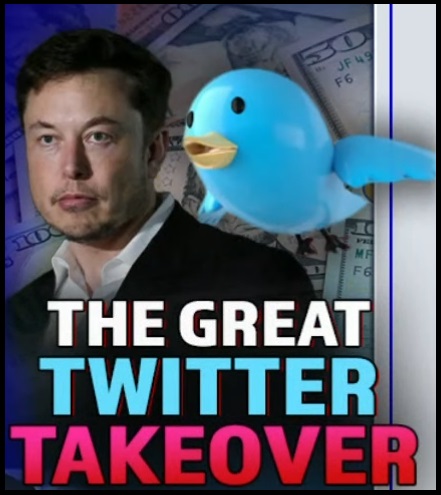Twitter Responds to Elon Musk Proposal by Creating Poison Pill
The social media and communication platform Twitter, responded to the bid by billionaire entrepreneur Elon Musk by announcing Friday the Twitter board of directors has unanimously adopted a “poison pill” defense in response to Tesla CEO Elon Musk’s proposal to buy the company and take it private. [LINK to Press Release]
 Twitter said the move, formally called a “limited duration shareholder rights plan,” aims to enable its investors to “realize the full value of their investment” by reducing the likelihood that any one person can gain control of the company without either paying shareholders a premium or giving the board more time. Poison pills are often used to defend against hostile takeovers.
Twitter said the move, formally called a “limited duration shareholder rights plan,” aims to enable its investors to “realize the full value of their investment” by reducing the likelihood that any one person can gain control of the company without either paying shareholders a premium or giving the board more time. Poison pills are often used to defend against hostile takeovers.
According to Twitter’s plan, if Musk or any other person or group acquires at least 15 percent of Twitter’s stock, the poison pill will trigger.
At that point, every other shareholder, aside from Musk, would be allowed to purchase new shares of Twitter at half the going market price, which stood at $45.08 at the closing bell on Thursday.
The flood of half-price shares would effectively dilute Musk’s ownership stake, making it massively more expensive for him to build up a controlling position. Twitter said its board had voted unanimously in favor of the plan, which will remain in effect until April 14, 2023.
Obviously, the people in control of Twitter really do not want to lose control over the platform. Elon Musk’s offer to purchase Twitter at $54.20 per share, represents a value of 38% more than his first shares purchased. The public shareholders would make a sizeable return on their investment. However, the fiduciary responsibility of a board of directors to its shareholders is really not what this is about.
In the big picture, Twitter is a bottomless pit of financial cost. Once you understand the technology behind Twitter, it is easy to understand why the public speech platform is not a viable business model, and it never was.
Twitter is exclusively a ‘user engagement‘ social media platform with no hosted content. Twitter is massively expensive to operate because the costs of operating the technology, all of which are driven by the substantive issue of ‘simultaneous users‘, exceeds the capacity of the platform to generate revenue.
Almost all other internet websites and social media have two structures: (A) Content, and (B) User Engagement.
Content represents a small part of any internet hosting expense for a platform and represents almost 100% of the platform’s ability to generate money. User engagement on the other hand, costs massive amounts of money – due to the need for data processing to handle the engagement and simultaneous users – and provides almost no revenue.
Many news and information content providers do not even host a user engagement commenting system any longer. User engagement is just too expensive and requires monitoring, moderation and massive amounts of data processing space on the platform servers.
Twitter’s operating model only consists of ‘user engagement.’
The platform itself is a massive global commenting system – the ‘public square’ discussion.
♦CONTENT is the material that can be monetized easily. Content is the article, graphic, podcast, or video you would see and watch. Content is profitable based on advertising. Eyeballs on content means eyeballs on internet advertising. This is how websites and content providers are able to pay for expenses and operate as a business model for the continuation of content. Hosting costs for content, even on a massive scale of viewership/readership are low, and the income from advertising increases with more readers and viewers. This is the traditional business model of content providers.
♦USER ENGAGEMENT is the part that is not as easily monetized, and user engagement drives a higher cost. User engagement is the comments, likes, dislikes and discussion that takes place based on the users who view the content material and discuss. More user engagement, particularly more simultaneous users, costs more money for the platform, because the random capability of the audience to interact with the server network creates exponentially more data processing demand. Data processing, not capacity, drives the cost.
Server capacity is a relatively easy issue to solve for content providers. In order to see the content, the host needs to ensure they have enough capacity for the audience to arrive and view, read, or watch the content without overwhelming the server network. Server processing speed and data performance are a part of the construct to ensure everything is smooth.
Server capacity is not the challenge for ‘user engagement.’ Processing trillions of simultaneous user-activated functions is the tech challenge for ‘user engagement.’ It’s not the capacity, it’s the data processing. As a result, it is far more expensive to operate social media than it is to operate a simple website construct, because user engagement is the entire premise behind social media.
 Facebook and Instagram have a more viable business model because users provide the content they host. Content can be monetized, and in the case of Facebook, Google, Instagram and YouTube they can also monetize the user that provides it. Twitter does not host content at all.
Facebook and Instagram have a more viable business model because users provide the content they host. Content can be monetized, and in the case of Facebook, Google, Instagram and YouTube they can also monetize the user that provides it. Twitter does not host content at all.
Facebook makes money by selling advertising like a traditional website. Facebook and Google have also specialized in the micro-targeting of advertising to very specific tailored advertising audiences. Advertising agencies pay a premium for the micro-targeting of a specific audience.
Facebook also makes money by selling data on users. You may remember the reference of Cambridge Analytica purchasing micro-targeting user information from Facebook for use in elections and voter targeting efforts. More recently, Facebook has cut out the middlemen and started micro-targeting for politics and getting paid directly by political campaigns for their efforts.
In almost all social media, the user is providing the content that the platform can monetize. In the Facebook example above, the platform can offset the extreme increases in user engagement costs (data processing) by making money from the hosted content, and from selling the data of the user (there are many purchasers).
However, for Twitter the business model problem is: (a) the absence of content to monetize, and (b) the extreme costs of user engagement that dwarf the “simultaneous user” data processing costs for Facebook.
As Facebook grows, they can grow their revenue. As Twitter grows, it increases their expenses massively and only moderately increases their revenue.
Twitter is not making a decision to decline the generous offer by Elon Musk because of stewardship or fiduciary responsibility to shareholders. The financials of Twitter as a non-viable business model highlight the issue of money being irrelevant. Twitter does not and cannot make money. Growing Twitter only means growing an expense. Growing Twitter does not grow revenue enough to offset the increase in expense.
There is only one way for Twitter to exist as a viable entity, people are now starting to realize this.
What matters to the people behind Twitter, the people who are subsidizing the ability of Twitter to exist, is control over the global conversation.
Control of the conversation is priceless to the people who provide the backbone for Twitter.
Once people realize who is subsidizing Twitter, everything changes.
That’s the fight.
.





Post a Comment